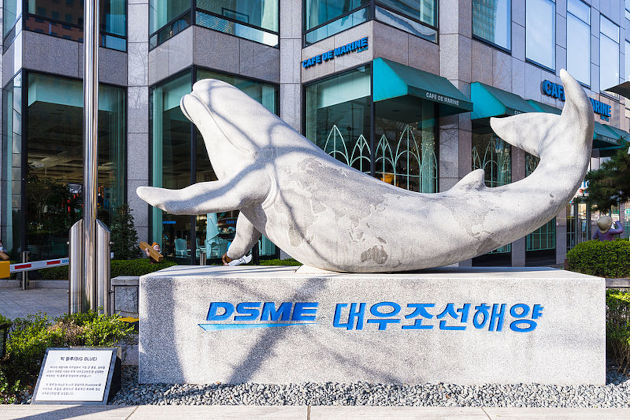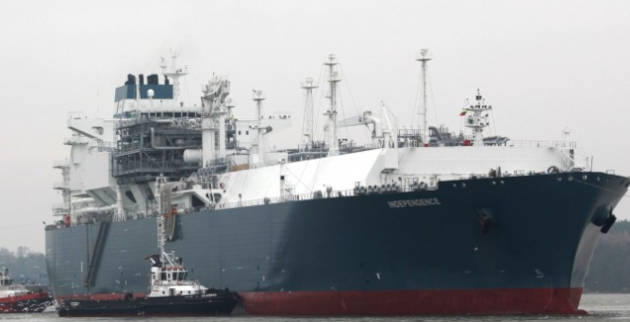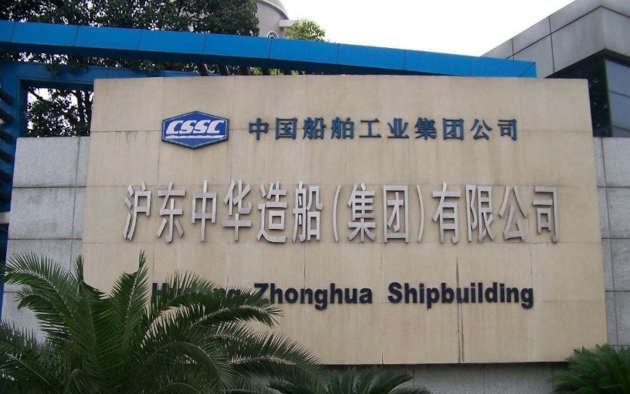Discover the top LNG ship builder(s) dominating the LNG orderbook.
- Top Builders of the LNG Orderbook
- Daewoo Shipbuilding and Marine Engineering (DSME)
- Samsung Heavy Industries
- Hyundai Heavy Industries
- Mitsubishi Heavy Industries
- Hudong Zhonghua Shipbuilding
- Kawasaki Heavy Industries
- Imabari Shipbuilding
- Japan Marine United
- Hyundai Samho Heavy Industries
- Jiangsu New Yangzijiang
Explore leading companies in the LNG industry known for their advanced technologies and superior craftsmanship.
Top Builders of the LNG Orderbook
The following notes provide profiles of the current top builders (ranked by m3 capacity on order) of LNG carriers, and their orderbooks as at 1st April 2017.
Daewoo Shipbuilding and Marine Engineering (DSME)
LNG Carrier Orderbook, 1st April 2017: 48 vessels (8,319 m m3).
In 1973, The Korea Shipbuilding & Engineering Corporation started construction on their Okpo shipyard.
Five years later, the site was acquired by Daewoo Shipbuilding & Heavy Machinery Co. Ltd. (DSHM) and the first vessel was delivered in 1979. DSHM merged with Daewoo Heavy Industries in 1994 and, following an internal restructuring of the Daewoo group, Daewoo Shipbuilding and Marine Engineering (DSME) was formed in 2000.
Daewoo is one of two yards (along with Samsung HI) to have delivered more than 100 LNG carriers in the past twenty years, and currently holds the largest LNG carrier orderbook of any shipyard by a significant margin.

Source: wikipedia.org
In recent years, the company has faced major financial difficulties, primarily driven by delays and cost overruns on rig and drillship projects in the offshore sector. As a result, Daewoo has received several government backed bail outs and is currently undergoing a significant restructuring, involving both the sale of major assets and downsizing of its workforce.
Although the yard has had some success in turning its fortunes around, reporting a KRW 262 bn ($230 m) profit in Q1 2017, the global slowdown in LNG contracting has provided a significant challenge.
Daewoo has won a reported five contracts since the start of 2016, of 13 signed globally, following orders for a record 37 vessels (54 % of the global total) of 6,4 m m3 in 2014. This dominance was reported to have been due in part to a patent that Daewoo secured on partial Liquefied Natural Gas Reliquefaction Plantreliquefaction technology at the start of 2014, which allowed it to outcompete rivals for new contracts.
However, in January 2017 the patent was invalidated following lawsuits brought by Samsung HI and Hyundai HI, which is likely to enable these yards to compete more effectively for orders.
In 2016, Daewoo secured orders for three 174 000 m3 LNG carriers from Angelicoussis-owned Maran Gas. One of these vessels, ordered in December, will be an FSRU (LNG/regasification unit), due to be delivered in 2020.
The yard has also won two further orders in 2017 so far, of five placed globally. In 2016 Daewoo delivered a total of five LNG carriers to three owners. These vessels included the “Christophe De Margerie”, the first in a series of 15 ice-breaking LNG carriers being built for the Yamal LNG project in Northern Siberia.
The vessel passed ice trials and has now docked at the Yamal terminal, having been delivered to Sovcomflot in November 2016. All vessels in this series are being built to an Arc7 ice class design, capable of breaking through ice at least 2,1 m thick. They will deliver gas to the Far East, travelling eastwards through the Russian Arctic in summer and westwards via the Barents Sea during winter.
Samsung Heavy Industries
LNG Carrier Orderbook, 1st April 2017: 16 vessels (2,786 m m3).
Samsung Heavy Industries, based in Geoje, South Korea, was established in 1974 following the opening of the yard’s Changwon Plant.
In 1977, the company’s shipbuilding division, Samsung Shipbuilding, was formed and, later that same year, the yard merged with Daesung Heavy Industries. In 1979, the shipyard’s number one dock was built, followed by its number two dock in 1983. Samsung HI, which delivered its first vessel in 1980, has subsequently developed into one of the world’s major shipbuilders, delivering a total of 107 LNG carriers since the start of 1996.
As of 1st April 2017, its orderbook across all sectors stood at 3,3 m CGT, almost equivalent in size to the orderbook at compatriot builder Hyundai HI. Like the other major Korean yards, Samsung has faced financial difficulties, again due mainly to delayed offshore projects, leading it to undergo a major restructuring programme.

Source: wikimedia.org
At the start of April 2017, the LNG carrier orderbook at Samsung HI totalled 16 vessels of 2,8 m m3, down 11 % year-on-year in m3 terms.
The yard took orders for two vessels in 2016, a pair of 180 000 m3 vessels being built for Greek owner GasLog. The vessels were ordered on the back of a seven year charter agreement with UK energy provider Centrica and are both scheduled to be delivered in the second half of 2019.
In 2017 so far, Samsung HI has won an order for a single vessel, a 170 000 m3 FSRU (LNG/Regasification unit) ordered by Hoegh LNG.
The FSRU will reportedly be deployed at the Tema LNG import terminal in Ghana, as part of a charter agreement between Hoegh and Quantum Power Ghana Gas. There are also options included for up to three more FSRUs.
Samsung HI delivered a total of six LNG carriers in 2016, four of which were ordered by GasLog.
All of these vessels have a capacity of 174 000 m3 and were ordered in 2013. Meanwhile, two 174 900 m3 vessels were delivered to Nigerian owner Bonny Gas Transport, from a series of four vessels ordered in 2013.
The units are all reportedly being used to transport gas from the Bonny Island LNG Project and were built with Wartsila 8L50DF Diesel Electric engines.
Hyundai Heavy Industries
LNG Carrier Orderbook, 1st April 2017: 13 vessels (2,190 m m3).
Whilst construction on Hyundai Heavy Industries (HHI) Ulsan shipyard didn’t start until 1972, the shipbuilder took its first newbuilding contract prior to this, winning orders for two 260 000 dwt VLCCs from Greek owner Livanos.
Construction of both the shipyard and ships, the “Atlantic Baron” and “Atlantic Baroness” finished in 1974. The yard expanded quickly to become one of the world’s largest; as of April 1st 2017 it had an orderbook of 65 vessels of 3,3 m CGT.

This orderbook has declined significantly since the beginning of 2016, including in the LNG sector. A total of 13 LNG carriers of 2,2 m m3 were on order at Hyundai HI as of the start of April, down 22 % year-on-year in m3 terms.
Although the yard has suffered less damaging financial losses than the other two “big 3” Korean builders in recent years, Hyundai HI has still faced difficulties, with its Gunsan yard due to cease operations temporarily from July 2017.
In 2016, Hyundai HI won two reported LNG carrier orders, a pair of 180 000 m3 vessels contracted by SK Shipping.
Both of these vessels are due to be delivered in 2019 and will reportedly transport gas from the Freeport LNG project in Texas. In the year so far, two vessels have been ordered at the shipyard:
- a 180 000 m3 LNG carrier being built for Knutsen OAS;
- and a 170 000 m3 FSRU (LNG/Regasification unit) ordered by Hoegh.
The FSRU has been ordered on the back of a charter agreement with Global Energy Infrastructure and will reportedly be deployed in Port Qasim, Pakistan.
Meanwhile, the yard delivered a total of 8 LNG carriers of 1,4 m m3 in 2016, the most of any builder globally, and has delivered two units in the year so far.
Mitsubishi Heavy Industries
LNG Carrier Orderbook, 1st April 2017: 10 vessels (1,670 m m3).
Mitsubishi Heavy Industries was formed in 1884 following the acquisition of the Nagasaki Shipyard from the Japanese Ministry of Industry. The yard controls a number of large shipyards based in Nagasaki, Kobe and Shimonoseki, as well as additional facilities in Hiroshima and Yokohama.
The group’s LNG carrier construction is focused at the largest of these facilities, its Nagasaki yard. As of 1st April 2017, the yard had 20 vessels of a combined 1,3 m CGT on order, the second largest orderbook of any Japanese yard in CGT terms.
Half of these vessels were LNG carriers, with MHI Nagasaki being the most prominent Japanese builder within the sector for a number of years. Mitsubishi Heavy Industries has led talks in recent months on increasing the degree of cooperation between Japanese builders through a more formal “alliance”.
Read also: Basic knowledge of tankers
The yard has typically built more complex vessels including LNG carriers, Ro-Ros and offshore units, and it has been reported that one of MHI’s major contributions could be the sharing of vessel technology.
MHI Nagasaki won eight LNG carrier orders in 2015, seven of which were placed by domestic owners. No new contracts have been signed by the yard since then and Japanese owners are not reported to have contracted any LNG carriers in 2016 or 2017 to date.
In 2016 the shipyard delivered two vessels, one 155 300 m3 LNG carrier to Mitsui O. S. K. Lines and another 155 693 m3 vessel to Osaka Gas. Both vessels are reported to have steam turbine propulsion and Moss containment systems.
Hudong Zhonghua Shipbuilding
LNG Carrier Orderbook, 1st April 2017: 8 vessels (1,392 m m3).
China State Shipbuilding Corporation (CSSC) owned shipyard Hudong Zhonghua was formed following the merger of the Hudong Shipbuilding Group and the Zhonghua Shipyard in 2001.
The Chinese shipbuilder, which currently operates two sites in Hudong and Zhonghua, currently has 29 ships of a combined 1,4 m CGT on order, the fourth highest total in CGT terms of any Chinese yard. Hudong Zhonghua has been more successful than most Chinese yards in taking orders for more complex, high value vessel types and most of its orderbook is accounted for by LNG carriers, chemical tankers and boxships of 8 000+ TEU (all ordered by COSCO Shipping Lines).

In the LNG carrier sector, Hudong Zhonghua has eight vessels of 1,4 m m3 on order, accounting for all LNG carriers above 45 000 m3 on order in China.
Hudong Zhonghua has not won an LNG carrier contract since 2014 but the yard is rumoured to be in the running for an order for four 174 000 m3 LNG carriers for the Yamal LNG project.
China National Petroleum Corporation has a 20 % stake in the Yamal project and this, along with the involvement of Chinese shipowners and finance, is reported to have supported the shipyard’s bid. All four LNG carriers are expected to serve 15 year timecharters, transhipping cargo from northern Europe to Asia.
In 2016 Hudong Zhonghua delivered a 172 000 m3 LNG carrier to Mitsui O. S. K. Lines and a 174 000 m3 LNG carrier to China Energy Shipping Investment with the second vessel in this series delivered to the owner in January this year.
All three ships delivered were equipped with GTT NO 96 membrane systems and MAN engines.
Kawasaki Heavy Industries
LNG Carrier Orderbook, 1st April 2017: 7 vessels (1,175 m m3).
Founded in 1878, Japanese shipbuilder Kawasaki Heavy Industries has two facilities located in Kobe and Sakaide. The Kobe facility generally builds less complex vessel types, particularly Handymax bulkcarriers, whilst the Sakaide facility constructs more complex ship types, including VLCCs, LNG carriers and LPG carriers.
As of the 1st April 2017, the total orderbook at Kawasaki’s Sakaide yard stood at 13 ships of a combined 0,8 m CGT.
Seven of these vessels were in the LNG carrier sector, totalling 1,2 m m3. Kawasaki HI is facing financial difficulties and is expected to downsize its shipbuilding operations in Japan by around 30 %, instead focusing on its Chinese joint venture yards in Dalian and Nantong.
It is reported that the construction of LNG carrier hull blocks may be outsourced to these facilities in China.
The shipbuilder last received an LNG carrier in September 2015 and the yard is currently scheduled to complete the delivery of its LNG carrier orderbook in 2018. The delivery of three LNG carriers ordered by the yard’s sister company K-Line has been delayed; originally scheduled for 2016 the vessels are due to be delivered later this year. The vessels will reportedly be deployed primarily on the Australia to Japan route.
Imabari Shipbuilding
LNG Carrier Orderbook, 1st April 2017: 6 vessels (1,068 m m3).
Japanese shipbuilder Imabari S. B. was founded in 1901. The Imabari Shipbuilding group currently controls a large number of facilities, including its Imabari, Marugame and Saijo yards.
In 2013 Imabari and Mitsubishi HI formed a joint venture in the LNG carrier sector, collaborating on vessel design, marketing and construction.
Construction of LNG vessels is focused at Imabari’s Saijo shipyard on Shikoku island. The yard has a total orderbook of 32 vessels, with the highest total CGT of any yard in Japan (1,9 m CGT, the sixth highest total globally).
As of 1st April 2017 there were six LNG carriers of 1,1 m m3 on order. All of these ships were ordered in 2013 or 2015, and the yard is yet to make its first LNG carrier delivery.
Imabari won 4 × 178 000 m3 LNG carrier orders in 2015; three of these vessels are scheduled to be delivered in 2022.
Two further ships ordered in 2013, the “Castillo de Merida” and “Castillo de Caldelas”, are due to be delivered to Spanish owner Elcano later this year. Export finance was secured for one of the vessels and it will reportedly be chartered to Spanish gas company Gas Natural Fenosa Group upon delivery.
Japan Marine United
LNG Carrier Orderbook, 1st April 2017: 5 vessels (0,825 m m3).
Japan Marine United (JMU) was formed in 2013 following the merger of two established Japanese shipbuilding groups, Universal Shipbuilding and IHI Marine United Corp. JMU manages a large number of facilities including its Ariake, Kure, Tsu and Maizuru shipyards.
JMU (Tsu) currently has five LNG carriers of a combined 0,8 m3 on order (out of a total orderbook of 11 vessels across al sectors).
JMU’s Tsu facility is scheduled to deliver its first LNG carrier this year with three 165 000 m3 vessels due to be delivered to domestic owners: two to Mitsui O. S. K. Lines and one to Nippon Yusen Kaisha.
These will be the first modern vessels to be built with SPB (self-supporting, prismatic-shape IMO Type B) containment systems which combine the advantages of membrane and Moss systems, increasing hold space utilisation and reducing the risk of “sloshing”.
The LNG carriers will be chartered to Tokyo LNG Tanker and will transport LNG cargoes from the Cove Point LNG project on the east coast of the US.
Hyundai Samho Heavy Industries
LNG Carrier Orderbook, 1st April 2017: 2 vessels (0,348 m m3).
Hyundai Samho shipyard was originally founded by the Halla Heavy Industry Group, with construction of the site starting in 1992. The South Korean yard delivered its first ship in 1996 and changed its name to Hyundai Samho HI three years later, when Hyundai Heavy Industries took over management of the yard, after the collapse of the Halla Group during the Asian financial crisis.
As of 1st April 2017, the shipyard had the eighth largest orderbook globally in terms of CGT, totalling 47 vessels of 1,8 m CGT across all vessel sectors. However, only two LNG carriers of a total 0,3 m m3 are currently on the orderbook.
The majority of vessels on order at the yard are crude tankers with PCCs, LPG carriers and large boxships accounting for the remaining orderbook. The yard has delivered 15 LNG carriers to date.
The LNG carrier orderbook at Hyundai Samho been in decline since the start of 2013, with the last reported orders at the yard in 2015. These were two 174 000 m3 LNG carriers contracted by Teekay LNG and are scheduled for delivery in 2019.
The shipyard delivered five 174 000 m3 vessels to Maran Gas in 2016 and a final vessel of a similar size to the same owner in January 2017, all are equipped with GTT MarkFlex containment systems.
Jiangsu New Yangzijiang
LNG Carrier Orderbook, 1st April 2017: 2 vessel (0,05 m m3).
Privately owned Jiangsu New Yangzijiang was established as a merchant shipyard in 2005 in Jingjiang, Jiangsu province. The yard made its first delivery in 2008, a feeder containership, and has since diversified its product mix into the dry bulk, offshore, LNG carrier and Ro-Ro sectors.
The Chinese shipbuilding industry is dominated by state-owned facilities and Jiangsu New Yangzijiang is one of the few large independent yards. As of 1st April, there were 84 vessels of a total 1,9 m CGT on order at the yard, the second largest orderbook amongst Chinese yards in CGT terms and the ninth largest globally.
Containerships and bulkers account for 96 % of the orderbook in CGT terms with two small scale LNG/Ethylene/LPG carriers of a combined 0,05 m m3 on order.
In February 2015, French owner Evergas contracted 2 × 27 500 m3 multi-gas carriers at the shipyard. These will be the first gas carriers ever built by the yard and are scheduled to be delivered in the first half of 2017.
Each of the vessels will be equipped with Cargo Containment Systems of LPG and LNGType C containment systems which require less up-front investment by the shipbuilder than membrane systems, though the yard plans to build gas carriers of up to 80 000 m3 in the future. The “Dragon” class multi-gas carriers are expected to serve a 15 year timecharter with INEOS upon delivery, transporting ethane cargoes between the US and Europe.
From a wider perspective, firm domestic demand for small scale LNG carriers to transport cargo along the Chinese coast is anticipated going forward as China invests more heavily in cleaner energy.
